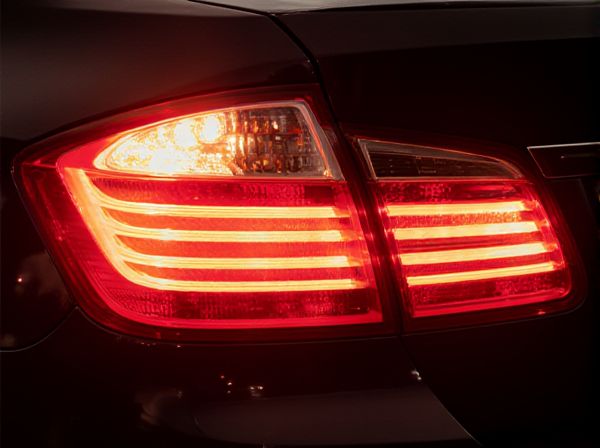
Photo illustration: Fiber Optic Taillight vs Incandescent Taillight
Fiber optic taillights provide brighter, more uniform illumination with enhanced energy efficiency and longer lifespan compared to incandescent taillights. Your vehicle benefits from quicker light response times and improved visibility, increasing safety on the road. Maintenance is reduced since fiber optic systems are less prone to bulb burnout and corrosion.
Table of Comparison
| Feature | Fiber Optic Taillight | Incandescent Taillight |
|---|---|---|
| Light Clarity | High brightness, uniform glow | Lower brightness, uneven light distribution |
| Energy Efficiency | Low power consumption | High power consumption |
| Lifespan | Up to 50,000 hours | Around 1,000 hours |
| Durability | Resistant to vibrations and shocks | Fragile filament prone to breaks |
| Heat Emission | Minimal heat generation | High heat output |
| Maintenance | Low, rarely needs replacement | Frequent bulb replacements required |
| Cost | Higher initial cost | Lower upfront cost |
Introduction to Taillight Technologies
Fiber optic taillights utilize thin strands of optical fibers to transmit light from a centralized LED source, enhancing brightness and design flexibility compared to incandescent taillights that use filament bulbs emitting light through direct electrical heating. Incandescent taillights, historically prevalent, operate by passing current through a tungsten filament, producing heat and light but with lower energy efficiency and shorter lifespan. Modern fiber optic systems offer improved durability, reduced power consumption, and sharper illumination, driving the automotive industry's shift toward advanced lighting technologies.
What Are Fiber Optic Taillights?
Fiber optic taillights use thin strands of glass or plastic fibers to transmit light from a centralized LED source, resulting in brighter and more efficient illumination compared to traditional incandescent bulbs. These taillights offer improved durability, resistance to vibrations, and faster response times, enhancing vehicle safety. Unlike incandescent taillights that rely on filament heating, fiber optic systems provide consistent light output with lower power consumption and longer lifespan.
Understanding Incandescent Taillights
Incandescent taillights use filament bulbs that emit light by heating a metal wire inside a glass enclosure, providing warm, easily visible illumination but with slower response times and higher energy consumption compared to fiber optic systems. These traditional taillights are valued for their low cost and straightforward replacement but suffer from shorter lifespans and increased heat generation. Understanding the limitations of incandescent taillights highlights the benefits of fiber optic alternatives in modern automotive lighting technology.
Light Efficiency Comparison
Fiber optic taillights deliver superior light efficiency by transmitting light evenly with minimal loss, producing brighter and more consistent illumination compared to incandescent taillights. Incandescent bulbs consume more energy and convert a significant portion of it into heat rather than visible light, resulting in lower luminous efficacy. Consequently, fiber optic systems enhance visibility and safety while reducing power consumption in automotive lighting applications.
Energy Consumption and Sustainability
Fiber optic taillights consume significantly less energy than incandescent taillights, as they efficiently transmit light without generating excessive heat. The lower power requirement of fiber optic systems contributes to extended vehicle battery life and reduced overall energy usage. Fiber optic technology also offers enhanced sustainability by utilizing longer-lasting, recyclable materials, reducing waste and environmental impact compared to the shorter lifespan and higher energy consumption of incandescent bulbs.
Durability and Lifespan
Fiber optic taillights offer superior durability compared to incandescent taillights, as they are less prone to damage from vibration and impact due to the absence of fragile filaments. The lifespan of fiber optic taillights typically exceeds 50,000 hours, significantly outlasting incandescent bulbs which average around 1,000 to 2,000 hours before filament burnout. This extended lifespan reduces maintenance frequency and replacement costs, making fiber optic taillights a more reliable choice for long-term vehicle lighting.
Design Flexibility and Aesthetics
Fiber optic taillights offer superior design flexibility and aesthetics compared to incandescent taillights by enabling intricate shapes and uniform light diffusion. The thin, flexible fiber optic cables allow designers to create visually striking patterns and seamless illumination without bulky components. Incandescent taillights, constrained by larger bulbs and limited light distribution, often result in less refined and bulky designs.
Safety and Visibility Performance
Fiber optic taillights offer superior safety and visibility performance compared to incandescent taillights due to their higher brightness and uniform light distribution. The rapid illumination speed of fiber optic technology enhances reaction times for drivers behind, reducing collision risks. Incandescent taillights tend to have slower response times and less consistent light output, which can compromise visibility in adverse weather conditions.
Cost Analysis and Maintenance
Fiber optic taillights offer higher initial costs due to advanced materials and manufacturing processes but provide long-term savings through greater energy efficiency and durability compared to incandescent taillights. Maintenance expenses for fiber optic systems are significantly lower since they resist corrosion, have longer lifespans, and require less frequent replacements, while incandescent taillights often incur higher upkeep costs due to frequent bulb failures and filament sensitivity. Cost analysis further favors fiber optics in commercial and fleet applications where reduced downtime and replacement frequency translate into measurable economic benefits.
Future Trends in Automotive Taillight Technology
Fiber optic taillights offer enhanced design flexibility and improved energy efficiency compared to traditional incandescent taillights, aligning with the automotive industry's shift towards lightweight and low-power components. Future trends emphasize integration of smart lighting systems using fiber optics for adaptive brightness, dynamic signaling, and vehicle-to-vehicle communication, enhancing safety and functionality. Innovations in materials and manufacturing techniques are expected to further reduce costs and complexity, accelerating the adoption of fiber optic technology in mass-produced vehicles.
 caratoz.com
caratoz.com